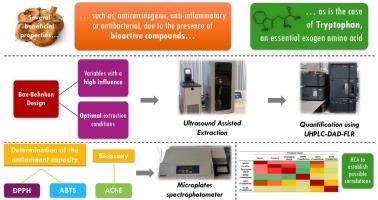开发一种新型环保超声辅助提取法,用于定量检测野生蘑菇中的色氨酸及其有益特性
IF 5.4
2区 医学
Q2 MATERIALS SCIENCE, BIOMATERIALS
引用次数: 0
摘要
食物中的生物活性化合物可影响细胞和生理功能,从而为健康带来益处。色氨酸是一种必需氨基酸,也是褪黑激素和血清素等神经递质的前体,可调节情绪和昼夜节律。然而,对蘑菇中色氨酸的定量研究却很少。我们优化了一种生态友好型超声辅助萃取(UAE)方法,利用带二极管阵列和荧光检测器(UHPLC-DAD-Fl)的超高效液相色谱法对色氨酸进行定量。测定了 26 种乳菇属和牛肝菌属野生蘑菇样品中的色氨酸含量。其浓度范围为 0.042 mg/g 至 0.742 mg/g。使用 DPPH(17.7 % - 71.6 %)和 ABTS(7.2 % - 24.9 %)方法评估了提取物的抗氧化能力,而乙酰胆碱酯酶(AChE)抑制活性介于 13.1 % 到 49.8 % 之间。研究结果令人鼓舞。层次聚类分析显示色氨酸浓度、蘑菇种类、地点和提取物特性之间存在相关性,突出了色氨酸在这些蘑菇的保健功效中的关键作用。本文章由计算机程序翻译,如有差异,请以英文原文为准。

Development of a new eco-friendly ultrasound-assisted extraction method to quantify tryptophan in wild mushrooms and determination of its beneficial properties
Bioactive compounds in food offer health benefits by influencing cellular and physiological functions. Tryptophan, an essential amino acid and precursor to neurotransmitters like melatonin and serotonin, regulates mood and circadian rhythms. However, its quantification in mushrooms is scarce studied. An eco-friendly ultrasound-assisted extraction (UAE) method has been optimized to quantify tryptophan using ultra high-performance liquid chromatography with a diode array and fluorescence detector (UHPLC-DAD-Fl). Tryptophan levels were determined in 26 wild mushroom samples of the genus Lactarius and Boletus. The concentrations ranged from 0.042 mg/g to 0.742 mg/g. The extracts' health benefits were assessed for antioxidant capacity using DPPH (17.7 % - 71.6 %) and ABTS (7.2 % - 24.9 %) methods, while acetylcholinesterase (AChE) inhibitory activity ranged from 13.1 % to 49.8 %. Promising results were obtained. Hierarchical cluster analysis demonstrated a correlation between tryptophan concentration, mushroom species, location, and extract properties, highlighting tryptophan's crucial role in these mushrooms' health benefits.
求助全文
通过发布文献求助,成功后即可免费获取论文全文。
去求助
来源期刊

ACS Biomaterials Science & Engineering
Materials Science-Biomaterials
CiteScore
10.30
自引率
3.40%
发文量
413
期刊介绍:
ACS Biomaterials Science & Engineering is the leading journal in the field of biomaterials, serving as an international forum for publishing cutting-edge research and innovative ideas on a broad range of topics:
Applications and Health – implantable tissues and devices, prosthesis, health risks, toxicology
Bio-interactions and Bio-compatibility – material-biology interactions, chemical/morphological/structural communication, mechanobiology, signaling and biological responses, immuno-engineering, calcification, coatings, corrosion and degradation of biomaterials and devices, biophysical regulation of cell functions
Characterization, Synthesis, and Modification – new biomaterials, bioinspired and biomimetic approaches to biomaterials, exploiting structural hierarchy and architectural control, combinatorial strategies for biomaterials discovery, genetic biomaterials design, synthetic biology, new composite systems, bionics, polymer synthesis
Controlled Release and Delivery Systems – biomaterial-based drug and gene delivery, bio-responsive delivery of regulatory molecules, pharmaceutical engineering
Healthcare Advances – clinical translation, regulatory issues, patient safety, emerging trends
Imaging and Diagnostics – imaging agents and probes, theranostics, biosensors, monitoring
Manufacturing and Technology – 3D printing, inks, organ-on-a-chip, bioreactor/perfusion systems, microdevices, BioMEMS, optics and electronics interfaces with biomaterials, systems integration
Modeling and Informatics Tools – scaling methods to guide biomaterial design, predictive algorithms for structure-function, biomechanics, integrating bioinformatics with biomaterials discovery, metabolomics in the context of biomaterials
Tissue Engineering and Regenerative Medicine – basic and applied studies, cell therapies, scaffolds, vascularization, bioartificial organs, transplantation and functionality, cellular agriculture
 求助内容:
求助内容: 应助结果提醒方式:
应助结果提醒方式:


